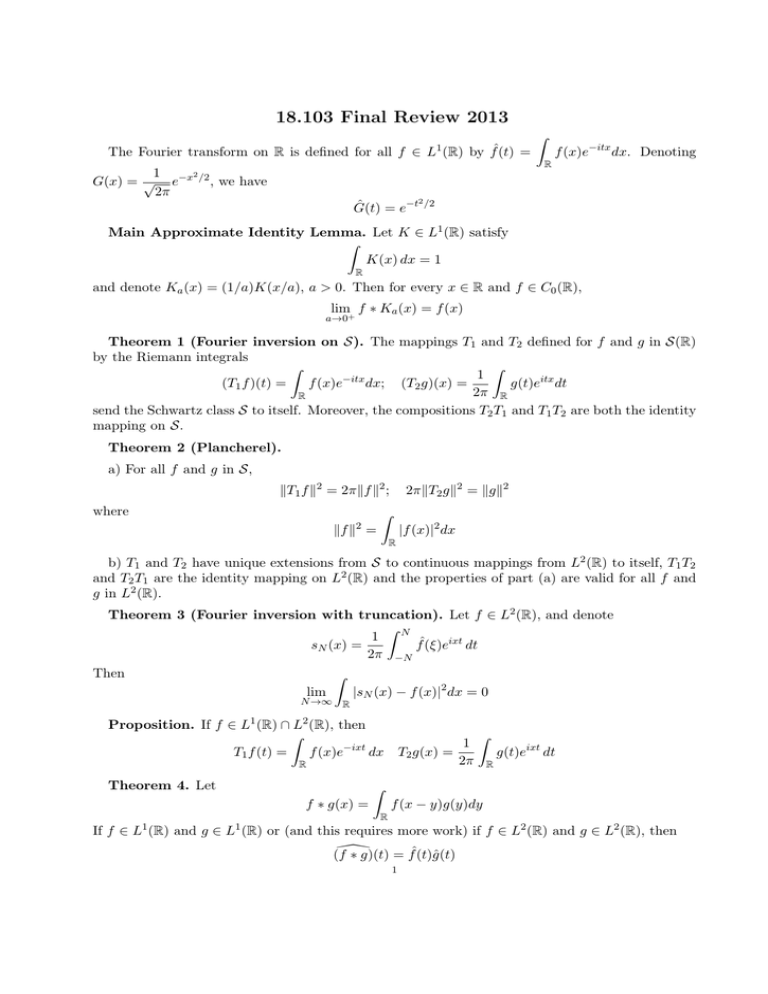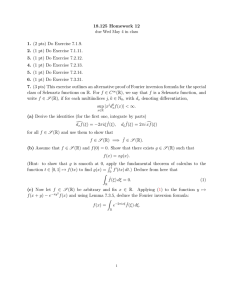18.103 Final Review 2013
advertisement

18.103 Final Review 2013
The Fourier transform on R is defined for all f ∈
L1 (R)
by fˆ(t) =
Z
f (x)e−itx dx. Denoting
R
1
2
G(x) = √ e−x /2 , we have
2π
Ĝ(t) = e−t
2 /2
Main Approximate Identity Lemma. Let K ∈ L1 (R) satisfy
Z
K(x) dx = 1
R
and denote Ka (x) = (1/a)K(x/a), a > 0. Then for every x ∈ R and f ∈ C0 (R),
lim f ∗ Ka (x) = f (x)
a→0+
Theorem 1 (Fourier inversion on S). The mappings T1 and T2 defined for f and g in S(R)
by the Riemann integrals
Z
Z
1
−itx
f (x)e
dx; (T2 g)(x) =
(T1 f )(t) =
g(t)eitx dt
2π
R
R
send the Schwartz class S to itself. Moreover, the compositions T2 T1 and T1 T2 are both the identity
mapping on S.
Theorem 2 (Plancherel).
a) For all f and g in S,
kT1 f k2 = 2πkf k2 ;
where
2πkT2 gk2 = kgk2
Z
2
|f (x)|2 dx
kf k =
R
b) T1 and T2 have unique extensions from S to continuous mappings from L2 (R) to itself, T1 T2
and T2 T1 are the identity mapping on L2 (R) and the properties of part (a) are valid for all f and
g in L2 (R).
Theorem 3 (Fourier inversion with truncation). Let f ∈ L2 (R), and denote
Z N
1
sN (x) =
fˆ(ξ)eixt dt
2π −N
Then
Z
lim
N →∞ R
|sN (x) − f (x)|2 dx = 0
Proposition. If f ∈ L1 (R) ∩ L2 (R), then
Z
f (x)e−ixt dx
T1 f (t) =
1
T2 g(x) =
2π
R
Theorem 4. Let
Z
g(t)eixt dt
R
Z
f ∗ g(x) =
f (x − y)g(y)dy
R
If f ∈ L1 (R) and g ∈ L1 (R) or (and this requires more work) if f ∈ L2 (R) and g ∈ L2 (R), then
\
(f
∗ g)(t) = fˆ(t)ĝ(t)
1
2
Review Problems
1.
a) Find the Fourier series of the function
(
1,
f (x) =
0,
0 < x < π;
−π < x < 0.
extended periodically with period 2π. Pay attention to three cases n = 0 and n 6= 0 odd and even,
separately.
b) Express your series with real numbers, sines and cosines.
c) At which points x does the series converge and to what value? Explain with statements of
theorems.
2. Suppose that f ∈ L2 (R/2πZ) takes the form
f (θ) =
∞
X
an einθ
n=1
Recall that if z = reiθ = x + iy,
F (z) =
∞
X
rn an einθ
n=1
is a harmonic (and even analytic) function in |z| < 1.
a) Why does the series for F (z) converge for |z| < 1?
b) Let fr (θ) = F (reiθ ), the values of F on the circle of radius r. Calculate kfr − f k2 in terms r
and an , and show that F takes on the boundary values in the sense that
lim kfr − f k2 = 0
r→1−
c) Evaluate the integral
Z Z
|(∂/∂r)F (z)|2 (1 − |z|) dx dy
|z|<1
in terms of the coefficients an . Explain at an appropriate point before, during or after the computation, why the integral is finite.
3. Fourier inversion on the Schwartz class S(R). (Approximate identity Lemma and Theorem 1
above.)
a) Recall that C0 (R) is defined as the class of continuous functions on R that tend to zero at
±∞. Show that if K ∈ L1 (R) and
Z
1
K(x)dx = 1;
Ka (x) = K(x/a), a > 0
a
R
then
lim f ∗ Ka (x) = f (x)
a→0
3
for every x ∈ R and every f ∈ C0 (R). Make use in your proof of the quantities
Z
|K(x)|dx; M = max |f (x)|
Q=
x∈R
R
and the modulus of continuity of f ,
ω(r) =
|f (x + y) − f (x)|
max
x∈R; |y|≤r
Z
1
b) Show that for every f ∈ S, f (0) =
fˆ(t)dt. You may assume without proof that for
2π R
every f and g in S, fˆ and ĝ belong to S and
Z
Z
f (y)ĝ(y)dy =
fˆ(t)g(t)dt
R
R
c) Deduce the Fourier inversion formula (formula for f (x) in terms of fˆ) for f ∈ S.
4. Fourier inversion formula on L2 (R) (Proof of Theorem 3 and the proposition above.)
a) For f ∈ L2 (R) and denote
1
sN (x) =
2π
Z
N
fˆ(t)eixt dt
−N
Explain why the integral defining sN (x) converges and why sN is continuous.
b) Prove that if f ∈ L1 (R) ∩ L2 (R), then
Z
(T1 f )(t) =
f (x)e−itx dx
R
following the three steps with *’s below.
You may assume that for any f ∈ L1 ∩ L2 , there is a sequence of functions fk ∈ S such that
kf − fk kL1 + kf − fk kL2 → 0 as k → ∞. Define
Z
Z
−itx
ϕk (t) =
fk (x)e
dx; ϕ(t) =
f (x)e−itx dx
R
R
* Show that ϕk (t) tends to ϕ(t) for each t as k → ∞.
* Show that kϕk − T1 f kL2 tends to 0 as k → ∞.
* Deduce that ϕ(t) = (T1 f )(t) (This equality holds in what sense?) Hint: Fatou’s lemma leads
to the fastest proof, but you may use other methods.
c) Deduce that
Z
lim
N →∞ R
|f (x) − sN (x)|2 dx = 0
using the statement analogous to part (b) for T2 and the other theorems on the page of theorems
as necessary.
5. Poisson summation formula. Let ϕ ∈ S(R). Show that
X
1 X
ϕ(2πn) =
ϕ̂(k)
2π
n∈Z
k∈Z
4
by calculating the Fourier series of
F (x) =
X
ϕ(x − 2πn)
n∈Z
in two ways.
6. Recall that
Py (x) =
1
2π
Z
∞
e−y|ξ| eixξ dξ =
−∞
1
y
2
π x + y2
satisfies for all x ∈ R and all y > 0,
∂2
∂2
+
∂x2 ∂y 2
Py (x) = 0,
In other words, Py (x) is harmonic in the upper half-plane {(x, y) ∈ R2 : y > 0} and for f ∈ L1 (R),
u(x, y) = Py ∗ f (x)
is harmonic in the upper half plane y > 0.
If f ∈ S(R), use the Fourier transform to calculate
Z ∞Z ∞
|∇u(x, y)|2 y dx dy
0
−∞
in terms of f . (Either before during or after the calculation, justify all the exchanges of integrals/differentiation/limits.)
MIT OpenCourseWare
http://ocw.mit.edu
18.103 Fourier Analysis
Fall 2013
For information about citing these materials or our Terms of Use, visit: http://ocw.mit.edu/terms.





